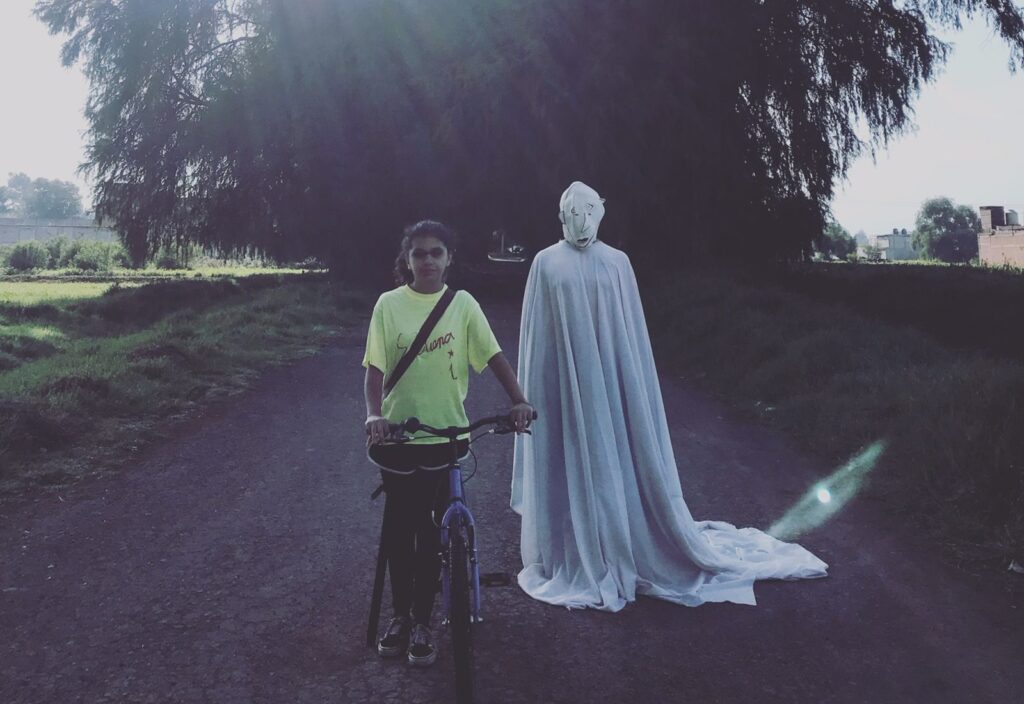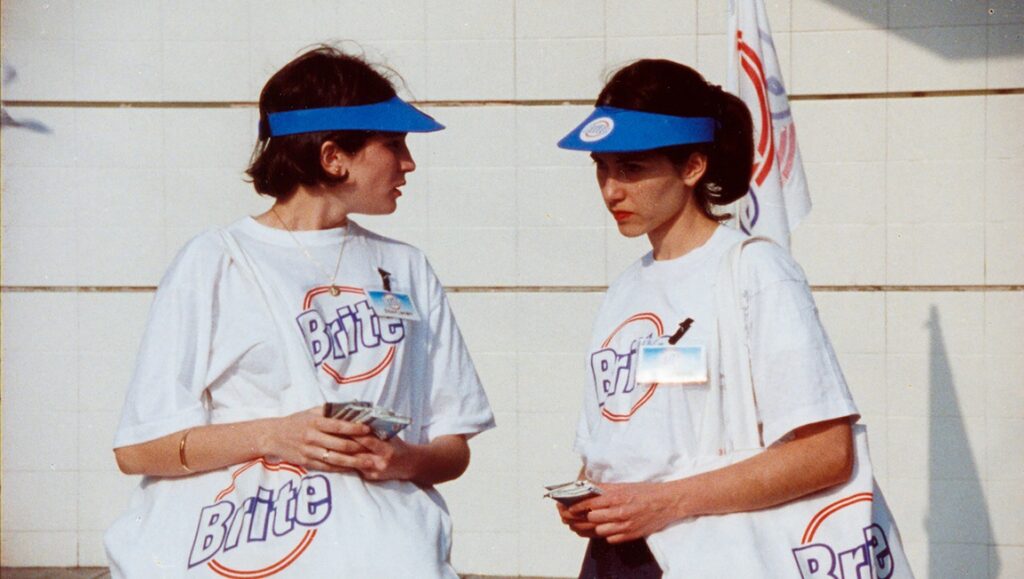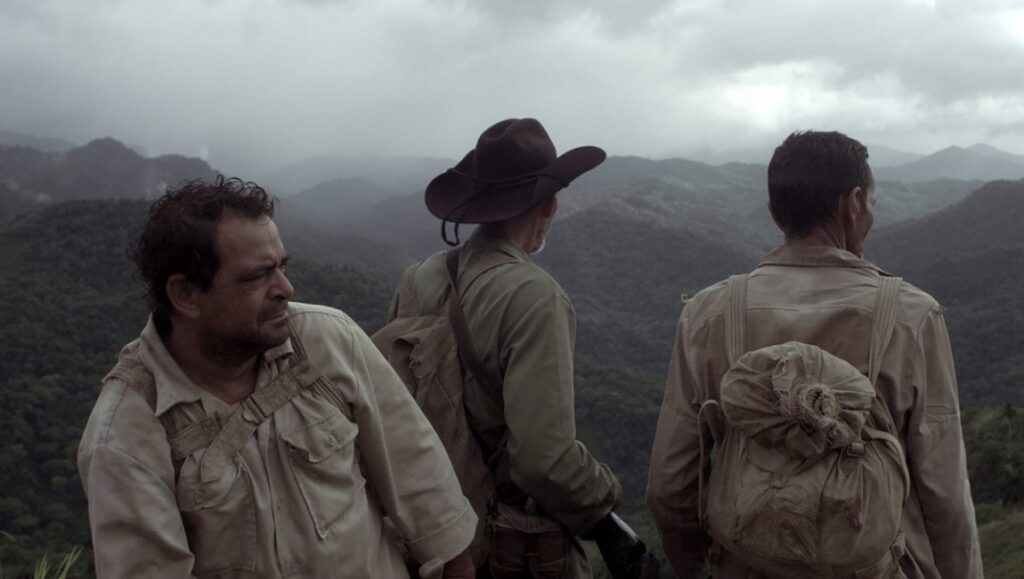Between Dog and Wolf
In Irene Gutiérrez’s Between Dog and Wolf, the relationship between past and present — and future — is vertiginous. We are left to deduce the time and place on the basis of some scattered memorabilia, and the age of the subjects. In the mountainous Sierra Maestra jungle, located in Southeast Cuba, Juan Batista Lopez, Miguel Soto, and Alberta Santana—all veterans of the Angolan War—reprise their wartime responsibilities and activities, roughing it in the wild, and maintaining their strength from a different era, one where the revolutionary spirit was more palpable. As the film’s voiceover intones, “Today everything has a less dramatic tone.”
A sense of loss presides over the documentary. The men discuss their fallen comrades, whom they feel they owe a continued duty to, highlighting their mentality at the time of the Angolan War, which was to either win or die. So the three work their way through the jungle once again: Following a brief opening of archival footage, the men are introduced, rather disarmingly, in camouflage, armed with sniper rifles, but with the specifics of their “mission” still withheld. Gutiérrez’s style is laconic, a paradoxical method of capturing all the burly training and travailing transpiring. Just as much time is dedicated to combative machete practice as to a refreshing dip in a mountain stream. Much of the film consists of communion with the jungle, though there’s also frustration, the observational camera capturing the durational heft and physical prowess necessary to enact this trek.
Juan, Miguel, and Alberta’s lives appear to exist only in the moment-to-moment progression offered by Between Dog and Wolf — a knotty impression, considering that they’re otherwise tethered to the past. Remarkably, this insularity is framed nonjudgmentally: testimonies, conversations, and physical ventures are all granted the proper breathing room. The film’s cyclical structure may strike viewers as noncommittal, but Gutiérrez’s lack of a personal stance regarding her chosen subject is appreciated. As the three men return to the jungle at the end, it becomes clear that this is no mere wargame, but a preservatory tactic for whatever the future may hold, even as the past seems further and further away.
Writer: Patrick Preziosi

All the Dead Ones
Having had its world premiere at last year’s Berlinale, Marco Dutra and Caetano Gotardo’s All the Dead Ones (in Portuguese, Todos os Mortos) has now made its U.S. debut as the opening night selection for Film at Lincoln Center and Cinema Tropical’s Neighboring Scenes festival. Although the Brazilian filmmakers are frequent collaborators (Gotardo edited Dutra’s 2017 feature Good Manners, for one), All the Dead Ones is the first time they’ve shared a directing credit, though they each have distinct bodies of work, spanning film, television, and theater, their careers dating back to the end of the ’90s when they met at film school. In the U.S., Dutra is likely best known for the aforementioned Good Manners (co-directed with Juliana Rojas) which found success at both Locarno and Fantastic Fest, while Gotardo’s films are largely unknown in the U.S. thanks to sporadic distribution (his Your Bones and Your Eyes did play Neighboring Scenes in 2019).
All the Dead Ones reflects the longevity and accomplishments of both Dutra and Gotardo’s artistic endeavors; in perfect sync, the directors have concocted an expansive historical epic of thematic and narrative complexity, gracefully paced and filled with clean, textured compositions. Set in São Paulo, approximately a decade after slavery was abolished in Brazil, All the Dead Ones is a gothic tale that concerns itself with the creeping decay of a once-powerful family of white landowners (a mother, two daughters, and an absentee father), and Iná (Mawusi Tulani), the woman they once enslaved. The latter now raises her son João (Agyei Augusto) on the outskirts of the city while waiting for the return of her husband, who has long been away searching for work. Eventually, Iná finds herself pulled back into the orbit of these former slave owners when they come to her in desperation, offering to pay her to travel to São Paulo and perform a ritual of African origin for the family matriarch, whose declining wealth has plunged her into a deep depression. Unable to turn down the money, Iná agrees, though the arrangement only grows more ominous as she’s reintroduced to the very unwell family, haunted and perverted by their colonialist dependencies.
Dutra and Gotardo approach this material with a certain grandiosity, their movie surely informed by art-house anti-colonialist screeds like those of Marguerite Duras (or more recently Zama and Zombi Child). All the Dead Ones convincingly adopts modernist affectations that are punctured, in the film’s closing minutes, by a rather cute moment that threads the horrors of colonialism and slavery up and through present day. That said, this very operatic rendering of such loaded, violent history often dances too close to camp: the actors play up the bizarre villainy of these warped aristocrats in a way that’s gaudy, which is particularly clear in the film’s closing minutes, when the silliness of a particular performance clashes with the bleak brutality of what is actually done. Still, while All the Dead Ones has its missteps, it’s clear that Dutra and Gotardo didn’t approach this project casually. There are moments when they fail to capture the complexity of the systems and histories they take on, but taken as a whole, the film is a welcome, unequivocal rejection of assimilation and assertion that colonization isn’t just a bad memory, but a present and still-honored tradition.
Writer: M.G. Mailloux
Samichay
Mauricio Franco Tosso’s Samichay, in Search of Happiness seeks to render the life of a peasant farmer on a grand, mythopoetic canvas, and it’s mostly successful, although its reach occasionally exceeds its grasp. Celestino (Amiel Cayo), a poor, indigenous Peruvian, lives in a small stone hovel high in the Andes Mountains, surrounded by rough, ragged terrain. Nothing grows here, the soil as inhospitable as the ominous peaks looming amongst the sky. A widower, Celestino has only his elderly mother-in-law, Augustina (Aurelia Puma de Ccallo), adult daughter, Yaquelin (Raquel Saihua Huainasi), and his cow, Samichay, as companions. Augustina chides him for his failures to provide food for them, while Yaquelin begs her father to let her move to the city, hoping to flee their empty, desolate life. Both women agree he should sell Samichay, who is as infertile as the land and cannot even provide milk for the family. Determined to prove his worth as a farmer, Celestino walks the land with Samichay in tow, convinced that the cow is good luck and that it’s only a matter of time before their fortunes turn. Tosso and cinematographer Hugo Carmona Chacon subsequently spend much of the film’s first half following Celestino at work, framing him against the vastness of the mountains as he works the Earth, tilling the soil and planting potatoes. It’s extremely slow-paced, but at its best, Tosso finds a soothing rhythm that suggests a trance-like sense of peace. This calm is interrupted when Yaquelin finally leaves home to live with an aunt in the city, and Augustina passes away in her sleep. Now totally alone except for Samichay, Celestino finally decides that he must sell the cow, setting off on a long journey by foot to find a buyer.
Shooting in widescreen, digital black-and-white, Samichay is not short on breathtaking imagery. Clouds gently roll off the mountain peaks, and long, winding roads are frequently covered in a hazy fog. Tosso tends to favor a specific camera movement, a slow pan to the left or right that sometimes even makes an entire 360° turn and takes in the full expansiveness of the landscape. It can be mesmerizing, but the shot’s frequency also produces a lulling effect. There are similarities here to Bela Tarr’s The Turin Horse, from the stylized cinematography and beast-of-burden iconography to an emphasis on the potato as signifier of impoverishment, but Tosso can’t match Tarr’s aggressive, impressively complicated mise-en-scène. Writer Gianna Giordani compares the film to the photographs of Martín Chambi, and suggests that Celestino’s journey is symbolic of the displacement of the Andean Indian population, a once large group of indigenous peoples that have assimilated or otherwise disappeared over the course of the 20th century. Whatever the case, the film builds to a shattering conclusion, and ultimately ends on an ambiguous note of uncertainty. Tosso has spent the better part of 90 minutes showing how difficult life can be in the unforgiving atmosphere of the Andes, but the drab, quotidian images of an anonymous city are no match for the grandeur of the mountains. They are always there, an implacable force, both majestic and harrowing.
Writer: Daniel Gorman

The Howls
In a vertically-oriented iPhone video, director Julio Hernández Cordón tells his daughter Fabi that he wants to make a movie with her. It will be set in his hometown of Texcoco and star his daughter and his friend Paco in ten separate roles, most of which are pulled from the director’s childhood. This sequence is as much a part of The Howls as it is an extra-textual introduction to it, as what follows is a documentary-fiction hybrid less concerned with blurring the lines between forms than it is in utilizing those lines to its specific ends. Much of the film involves Fabi searching for Lake Texcoco, upon which the Aztecs built Tenochtitlan and which, thanks to 20th-century urbanization, no longer exists. Interspersed with scenes of Fabi interacting with Paco’s characters — in the first, he plays her grandfather and presents her with the family rifle — are more straightforward documentary elements, like interviews with town elders about their memories of the lake and knowledge of its history. Most compelling are segments in which the director appears, face covered, to whisper narration into his daughter’s ear. She repeats what he says, and can’t help but smile at recounting the stories of her father’s youth.
This is an ambitious, thoughtful film that combines familial and cultural history into a single, inextricable whole: the poetry of King Nezahualcoyotl is as important as Cordón’s wistful memories of his youth. The Howls is as inflected with the joy of a father sharing his personal history with his child as it is mournful about the destructive encroachment of modern civilization on the land. This modern world, one obsessed with technological progress and which has privatized water, has drained a lake of utmost importance to a region and its people’s history. Given this layered approach, the film’s form and function might give the impression of something more cerebral, but Cordón’s film is refreshingly down to earth, marked by a clarity of information and a wholly unpretentious voice, neither obtuse nor overbearing. One does not have to grasp for meaning in these images or come into the film equipped with knowledge of Mexican history — some specific history not easily inferred is even relayed over the end credits — to pick up on precisely what Cordón seeks to convey. But while the documentary goals of The Howls are certainly realized, the fiction half of this hybrid wears thin even over its brief 68 minutes. At first, watching Fabi play-acting her father’s memories is charming, but the rhythm that these scenes settle into starts to become grating, and the beauty of the film’s images begins to look more like a cheap signifier of whimsy as it leans into the aesthetics of an iPhone commercial. Thankfully, the climax of the narrative, such that it is, affords a terrific summation of the film’s aims, rendering more worthwhile some of the film’s lesser fiction threads, and at least ending things on an up note.
Writer: Chris Mello
Chaco
Pitched somewhere between the bone-dry absurdism of Lucrecia Martel’s Zama and the minimalist drone of Lisandro Alonso’s Los Muertos, Diego Mondaca’s Chaco refashions the war picture as an existential journey through a barren, purgatorial landscape that ends in annihilation. An introductory title card offers some brief contextual information: the year is 1934, and a retired (or perhaps exiled) German captain is leading a small band of indigenous Bolivian soldiers in the country’s war with neighboring Paraguay over the disputed Chaco region. Captain Aleman (Fabián Arenillas) can barely conceal his contempt for the men under his charge, nor be bothered to muster enthusiasm for their mission. Acting as a valet of sorts for Aleman is Liboro (Raimundo Ramos), who is despised by his fellow soldiers for currying favor with the Captain. Liboro seems to be friends, or at least friendly, with Jacinto (Fausto Castellón), who is eventually tortured for attempted desertion. But no other details about the conflict are given, nor is there any traditional character development. Instead, we are given an elemental story about man vs. nature.
Mondaca films scenes in largely static master shots, with minimal camera movement and infrequent edits. There’s a languid quality to the film, as this group of men trudge through the harsh, unforgiving landscape, desperate for food and water. Mondaca occasionally highlights the ridiculousness of upholding regimented authority in such an environment — the soldiers unenthusiastically hoist the Bolivian flag on makeshift poles whenever they stop to make camp, and in one darkly comic scene, three men go through the motions of a formal changing of the guard in the middle of the night, even though there’s no one else in sight. Eventually admitting that the squad is lost, Aleman breaks his group into two, with himself and a few others venturing onward in the hopes of encountering the enemy or finding supplies. No Paraguayans are ever seen in the film, existing only as a kind of phantom threat, but the men do stumble upon an abandoned campsite and begin attempting to dig out a dried-up well. Their efforts are for naught, and the group descends further and further into madness, succumbing to heat and the pangs of hunger. A cryptic ending seems to suggest that the real horror of war is dying alone, in the middle of nowhere, fighting over useless, desolate land (unremarked upon is how much of the conflict was stoked by outside imperialist forces, with large European- and US-based companies jockeying for presumed oil reserves in the region). Mondaca dedicates the film to his grandfather, whose stories about the war the film is loosely based on, and Chaco frequently and fittingly plays like a half-remembered fever dream. These men are specters, anonymous pawns in a long-ago war, disappearing back into the land. In Mondaca’s hands, then, Chaco becomes an act and document of haunting remembrance.
Writer: Daniel Gorman

Silvia Prieto
Rightly considered one of the most prominent figures for the Argentinean new wave of cinema, Martín Rejtman first stepped into the attention of a small group of local cinephiles through his debut feature, Rapado in 1992, when the Argentine narrative film industry was struggling with unimaginative naturalist and often typical politically-charged work. Being an off-beat comedy, Rapado reflected Rejtman’s stylistic eccentricity from the beginning and successfully laid a solid foundation for later works. Originally released in 1999, Rejtman’s second feature, Silvia Prieto solidified the promise of Rejtman’s previous experiences. A serio-comedy that, on the one hand, reflects the author-turned-filmmaker’s fascination for literary narration and dialogue, and on the other hand, delicately alternates between a minimalistic realism and a stylistically refined absurd screwball. Following its eponymous, middle-class lead (Rosario Bléfari), Silvia Prieto is from the start a deadpan urban satire, where the main character — a directionless, Buenos Aires divorcée and a stiff, obsessively calculating young woman — soon finds herself within some uncanny situations: encountering her same-name doppelgänger in a phone book, dating her ex-spouse’s new date’s former spouse. In fact, it’s all a bit hard to describe, as Rejtman shapes a very specific ouroboros-like universe around Silvia and the other young characters. The dialogues mostly revolve around money, financial issues, television, or beauty products, which all structure a web-like world mainly ruled by capitalist relations, the media, sex, and consumerism.
Mostly consisting of a series of medium two-shots, with Rejtman’s camera fixed directly toward a pair of actors and rarely cutting a scene into different angles, the director succeeds at rendering the verbal and vibrational interactions between characters — who usually seize the day just by dawdling their time eating or aimlessly blabbering in cafes or while cooking meals at homes — with gentle empathy. Characters here are frequently impulsive, their decisions often foolish, and indeed, it’s not hard to find some similarities between Rejtman’s directorial instincts and those of Èric Rohmer or even Howard Hawks. But he distinguishes his work through a singular, poker-faced sense of humor, his easy authenticity easily traced to the burgeoning later generations of Argentinean filmmakers, most notably in the work of someone like Matías Piñeiro. It’s no surprise, then, that while Silvia Prieto is a film that boasts a soft, cold color palette and rides the wave of Rejtman’s elliptical editing, its core character is altogether warmer — the profound and often heartfelt pursuit of meaning and identity in life. Silvia Prieto seeks to convey the cruciality of finding both belonging and self-discovery, reveling in the act of reclaiming one’s own voice in order to narrate one’s own story, however confused it may be. Because even when one’s surroundings seem to be overblown with deafening, ambient silence (another of the film’s stylistic tics), and although living in an uncaring modern world where the words of men and women can be absurdly futile and distancing, Rejtman understands that one must always endeavor to re-engage with the self and with others. Silvia Prieto/Silvia Prieto is a beautiful reminder of just that.
Writer: Ayeen Forootan


Comments are closed.